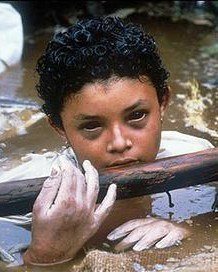Omayra Sánchez: The tragic truth behind the famous photo
In November 1985, the world witnessed a tragedy that left an indelible scar on humanity. When the Nevado del Ruiz volcano erupted, it unleashed a devastating mudflow that buried the town of Armero in Colombia, wiping out nearly everything in its path.
Over 25,000 lives were lost in one of the most catastrophic natural disasters of all time. Amid the destruction, a single haunting image came to symbolize the unimaginable suffering: a young girl, Omayra Sánchez, trapped in the volcanic mudflow, her fragile face etched with courage and despair.
Captured by photojournalist Frank Fournier just hours before her death, the photograph shook the world. It won the prestigious World Press Photo of the Year in 1986 and remains one of the most powerful images of human vulnerability. But behind the lens, a question still echoes: Why didn’t the photographer save her?
Caution: This article contains material that may be disturbing to some readers.Inside the Armero tragedy
To truly understand the heartbreaking photograph of Omayra Sánchez, we must first revisit the devastating event known as the Armero tragedy.
On November 13, 1985, the Nevado del Ruiz stratovolcano erupted after 69 years of dormancy, catching nearby towns completely off guard.
Nevado del Ruiz had erupted twice before — once in 1595 and again in 1845. On both occasions, avalanches roared down the Lagunilla River, the very area where the town of Armero would later be built.

Months before the 1985 eruption, experts had detected increased volcanic activity and warned Colombian authorities of the looming danger. Researchers, climbers, and political figures sounded the alarm about an impending disaster, but their warnings were largely ignored, despite clear signs of what was to come.
Farmers reported finding dead fish in nearby basins. Additionally, large amounts of sulfur were detected, and small explosions in the area even triggered a forest fire.
Yet, despite these warnings, no evacuation took place.
94% of the population was wiped out
As the volcano’s crater unleashed devastating pyroclastic flows, it rapidly melted the glaciers atop Nevado del Ruiz, sending four massive lahars — fast-moving mudflows, landslides, and debris — hurtling down its slopes at terrifying speeds of 50 km/h (30 mph). The lahars gained momentum as they rushed through gullies, ultimately engulfing the town of Armero in their deadly path.
According to Colombian sources, the eruption claimed the lives of around 23,000 people — nearly 94% of Armero’s population. The eruption’s smoke and ash soared up to 15 kilometers high, dramatically altering the region’s climate and leaving it in a state of devastation. Entire neighborhoods were wiped out, with 5,092 homes destroyed, 4,718 of them in Armero alone.
The disaster left 230,000 people impacted, with material losses estimated between 35 and 50 billion Colombian pesos, which translates to approximately $7.5 million to $10.5 million USD.
Story of Omayra Sánchez Garzón
Among the many victims was 13-year-old Omayra Sánchez Garzón, whose tragic situation drew the world’s focus.
Omayra Sánchez was born on August 28, 1972, in the town of Armero, where she grew up with her parents, Álvaro Enrique, who worked as a rice and sorghum collector, and María Aleida, a nurse. She shared her home with her brother, Álvaro Enrique, and her aunt, María Adela Garzón.

On the night of the Armero catastrophe , Omayra and her family were awake, concerned about the ash from the erupting Nevado del Ruiz volcano.
As they anxiously watched, they suddenly heard the deafening sound of an approaching lahar. When the massive eruption buried the Andean valley of Armero under a sea of mud, Omayra became trapped beneath the wreckage of her home, with concrete and debris pinning her down, making escape impossible.
A brave soul in the face of despair
As rescue workers arrived, they found her legs trapped under the rubble, her aunt’s lifeless arms still tightly clutching her. Despite efforts to pull her free, the task seemed impossible — any attempt to move her risked causing further harm. Her legs were trapped so tightly that rescuers placed a tire around her to keep her afloat as rising water surrounded her. Though the rescuers tried everything they could, it soon became clear that the situation was dire.
Doctors determined that the only way to free Omayra was by amputating both of her legs at the knees. However, there was no equipment available to perform the necessary surgery.
For over 60 hours, Omayra remained trapped, submerged in water, her body slowly succumbing to the elements. Yet, she never lost her calm demeanor. She spoke to a volunteer journalist, asking for sweet foods, singing, and even agreeing to an interview. But as the hours wore on, fear crept in.
She began hallucinating, talking about school and a math exam she thought she had missed. Her hands swelled and her face reddened as the water continued to rise. Still, she clung to life.
She was a courageous girl.
”I don’t feel my body anymore,” she said.
The famous photograph
Omayra’s story could have been different. Had the authorities acted upon the early warnings that had been issued, perhaps Omayra’s fate would have been another tragedy avoided. Yet, as the hours passed, it became impossible to save her.
Lacking the surgical equipment needed to amputate her legs and relieve the pressure, the doctors on site had to make a heart-wrenching decision: to let her die peacefully rather than subject her to further suffering.
It was in this final moment, when Omayra’s life was slipping away, that a French journalist named Frank Fournier arrived. He had flown into Bogotá just days after the eruption, and as he made his way to Armero, he was struck by the haunting silence and devastation.

“All around, hundreds of people were trapped. Rescuers were having difficulty reaching them. I could hear people screaming for help and then silence – an eerie silence,” he told the BBC two decades after the horrifying disaster. “It was very haunting.”
A farmer led him to Omayra, whose body was already beginning to show signs of swelling. Fournier, moved by her quiet courage and the agony she endured, snapped a photograph — a moment frozen in time that would come to symbolize the helplessness of the situation and the failure of those in power.
Fournier later reflected on the profound impact of the image, stating, “She was facing death with courage and dignity.”
Omayra Sánchez’s last words
On the morning of November 16th, at 9:45 AM, Omayra Sánchez closed her eyes for the last time. Just two hours before, a rescuer had reassured her, saying, “Relax, sweetheart, we’re going to get you out in just a minute. You’re going to live many years.” At that moment, the water had risen to her neck, and coffee beans were tangled in her hair.
Witnesses capturing the scene managed to film her last words, as the girl softly said, “Mommy, I love you so much, daddy I love you, brother I love you.”
Omayra’s brother survived the lahars; her father and aunt died. Her mother, María Aleida, also survived – before the eruption, she had gone to Bogotá on a business trip.
“It is horrible, but we have to think about the living,” Aleida said, referring to survivors like herself and her 12-year-old son, who lost a finger during the disaster.
Why didn’t the photographer help her?
Frank Fournier’s photo of the scene, titled The Agony of Omayra Sánchez, would become an iconic image, drawing international attention to the tragedy.
As the image spread across the globe, it ignited a firestorm of debate. Many, including the BBC, were horrified by the raw intimacy of the image, feeling as though they had witnessed the last moments of a young girl’s life.
Critics accused Fournier of exploiting Omayra’s suffering, calling him a monster for taking such a personal photograph. But Fournier defended his decision, saying that the photograph had helped raise crucial funds for the victims and highlighted the irresponsibility of the country’s leadership.

Despite the controversy, the photograph went on to win the prestigious World Press Photo of the Year in 1986. It captured the world’s attention and shone a light on the horrors of the Armero disaster.
As the photo continued to spread worldwide, some questioning why Frank hadn’t attempted to rescue Omayra from the lahar. He explained to the BBC that, given the dire situation, rescue was simply impossible. “There was a huge outcry — television debates on whether photojournalists are vultures,” Fournier reflected.
“But I felt the story needed to be told, and I was actually relieved by the reaction. It would have been worse if no one cared at all.”
Remembered in numerous ways
The impact of the photograph capturing Omayra Sánchez’s final moments is undeniable. Manuel Martín Benitos, a family friend, vowed to honor the young girl’s tragic death by turning it into a symbol of triumph.
In 1986, he established the International Foundation Omayra Sánchez with the mission of creating a global network of teams dedicated to preventing similar disasters and supporting the victims of catastrophic events.
Over the years following the eruption, Sánchez has been remembered in numerous ways, particularly by publications like El Tiempo. While many of the disaster’s victims were commemorated, Sánchez’s story has resonated deeply, inspiring poems, novels, and music that continue to keep her memory alive.
Armero today
In an effort to prevent future tragedies, the Colombian government created the Oficina Nacional para la Atención de Desastres (National Office for Disaster Preparedness), now known as the Dirección de Prevención y Atención de Desastres (Directorate for Disaster Prevention and Preparedness). As part of these efforts, all cities in Colombia were instructed to develop disaster preparedness plans.
In a poignant tribute to Sánchez, a species of cricket found in the region of the Armero tragedy was named Gigagryllus omayrae in her honor, ensuring that her legacy endures in both human and natural history.
Although the volcano Nevado del Ruiz remains active, the city of Armero no longer exists. Today, the site serves as a memorial, marked by Christian crosses and a small monument dedicated to Sánchez’s memory.
”Her face, her words, and her courage, which streamed throughout the world on television and were a heartbreaking image in the largest newspapers and magazines of the United States and Europe, remained a testimony of accusation against those who could have at the very least made the tragedy less serious.”
Germán Santa María Barragán in El Tiempo, November 23, 1985
Omayra’s name has lived on in the hearts of those who saw her suffering, a symbol of the innocence lost in a moment of incomprehensible disaster.
And for those who witnessed her final hours, her story is a haunting memory — one that should never be forgotten



